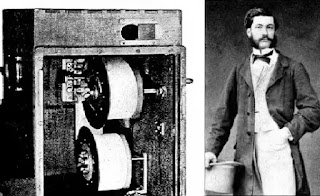The Forgotten Father of Cinema: Louis Le Prince and His Disappearance
The Forgotten Father of Cinema: Louis Le Prince and His Disappearance
Louis Le Prince is considered to be one of the pioneers of motion picture technology, as he was the first person to film moving images. In the late 1880s, Le Prince used his single-lens camera to capture a series of short films, including “Roundhay Garden Scene” and “Traffic Crossing Leeds Bridge.” These films, which were only a few seconds long, were considered to be the first motion pictures ever made.
 |
Louis Le Prince
However, Le Prince’s contributions to the world of cinema were soon overshadowed by a man who would become one of the most famous inventors of all time: Thomas Edison. In 1890, Le Prince disappeared without a trace, leaving behind a wife and children.
Edison, who was also experimenting with motion picture technology at the time, took credit for inventing cinema and even took Le Prince’s son to court to dispute it. Le Prince’s son later died under mysterious circumstances, adding to the mystery surrounding Le Prince’s own disappearance.
While Thomas Edison is often credited as the inventor of motion pictures, it’s clear that Le Prince’s contributions were just as important. Without his early experiments and innovations, the development of cinema as we know it today may have been delayed. Despite the fact that Le Prince’s name has been largely forgotten by history, his legacy lives on through the films he created and the technology he pioneered.
THE MYSTERY OF LOUIS LE PRINCE
The tale of Louis Le Prince, the man regarded as the father of cinematography, ended in rather peculiar circumstances which have yet to be resolved. But for movie lovers everywhere, it’s his achievements in the last few years of his life which have granted him a place in the history books.
While Thomas Edison and the Lumière brothers dominated the headlines for inventing the equipment which made the moving image possible, Louis Le Prince preceded them by a number of years with a working model which captured motion outside his home in Roundhay, Leeds.
However, his achievements were not widely recognised—because shortly before a scheduled public performance of his technology, Le Prince went missing with no clues as to his whereabouts.
Many people have since speculated on his fate (with theories ranging from suicide to murder by rival cinematographers), but the one undisputed fact is that Le Prince was the first past the post with his pioneering work in the medium which would ultimately become film.
WHO WAS LOUIS LE PRINCE?
He was born in Metz, France in 1841 and had the fortune during his youth of regularly visiting a studio belonging to a friend of his father—the photographic inventor Jacques Daguerre.
After studying chemistry and physics at university, Le moved to England at the invitation of John Whitley, before establishing the Leeds Technical School of Art where he specialised in tinting and firing of photographic images.
His Inventions and Achievements
Le Prince 16-lens camera (interior), 1886, Louis Aime Augustin Le Prince
During the 1880s, Le Prince became fascinated with the early cinematic technologies which were then being developed. In 1886 he created a 16-lens camera and applied for an American patent on 2 November of the same year, receiving this at the beginning of 1888; on 16 November 1888, he received a British patent for his invention.
His Single-lens Cine Camera, currently on display in our Animation Gallery, is believed to be the equipment used to film the famous Roundhay Garden and Leeds Bridge scenes. It proved to be one of the most groundbreaking inventions of early cinema.
1888, Louis Aime Augustin Le Prince
While the contraption, which utilises paper-backed stripping film, may appear primitive by today’s standards, evidence that the equipment was successful in projecting moving images means that Prince’s movies pre-date those of Edison and the Lumières by over half a decade.
In a cruel twist of fate, however, his disappearance meant that the world’s first movie maker never got the chance to accept the plaudits that came with such an achievement during his lifetime. He has since been posthumously rewarded his rightful status as the ‘Father of Cinematography’.
The first successful moving images in the world were recorded in Yorkshire, and it’s fitting that the equipment used to create them now lives here in Bradford, the world’s first UNESCO City of Film.











Comments
Post a Comment